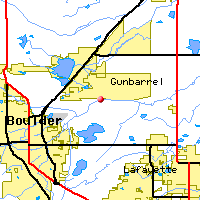|
|

|
BASIN-USGS-COB Boulder Creek Millenium Baseline |
|
Boulder Creek Watershed
Turbidity Data for 2000 - Boulder Creek above WW Plant |
Preliminary Data - subject to revision
|
|
|
|
Information on Turbidity:
Turbidity
is a measure of the cloudiness of the water. Cloudiness is caused by suspended solids or organic matter including silt, microorganisms, plant fibers, sawdust chemicals and coal dust. High levels of turbidity can block light from reaching submerged aquatic vegetation and can raise surface water temperatures because the suspended particles absorb heat from sunlight. The most frequent causes of turbidity are from logging, road and building construction, and mining activity. Turbidity affects fish by decreasing light penetration thus reducing the amount of photosynthesis taking place in the water. This reduces the amount of oxygen available to fish. Large amounts of suspended solids can also clog fish gills, and it affects their ability to see and catch foo
|
|
More general information about Turbidity
|
|
|
Interpretation of Boulder Creek Turbidity data
|
|
|
|
Monitoring site information: |

|
- Location: Boulder Creek above WW Plant
- Name: BC-aWWTP
- Type: Composite
- Frequency: SemiAnnual
- Longitude: 105 ° W 11'
- Latitude: 40 ° N 30'
- Elevation: 5125 feet asl
- Site photo
|
|
| Downstream Site: Boulder Creek at 61st St. |
| Upstream Site: Boulder Creek at 75th St |
|
| Date |
Turb
NTU |
| June, 2000 |
10.20 |
| October, 2000 |
5.30 |
| *value below detection limit: |
|---|
| Detection Limit (if available) |
0.01 |
|---|
|
Preliminary Data - subject to revision
|
|
Select on the parameter name to view all Turbidity time series plots on the basin map.
Select on the table date to view stream Turbidity profiles observed on that date.
Select here to view all parameters at this site.
|
|
|
INVITATION
BASIN is a community project actively seeking public participation. We
appreciate all feedback and welcome comments, suggestions and contributions.
To find out more about how you can be involved, click here.
|
|
| BASIN is funded through the US EPA EMPACT Program | |
|
Home
| Site Map
| Glossary
| Bibliography
| Contributors
About BASIN
| Attribution
| Feedback
| Search
|

